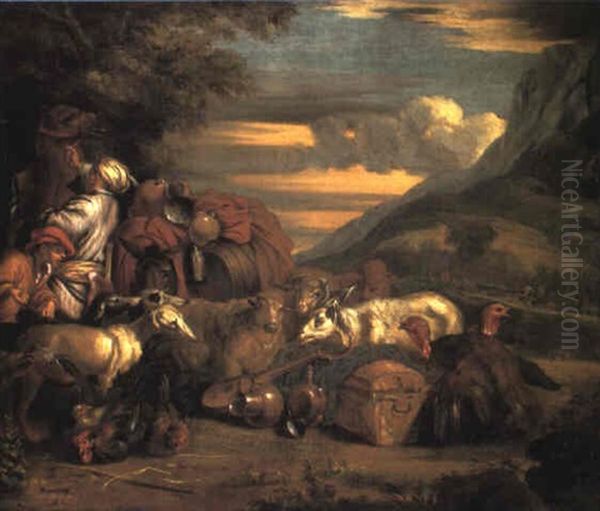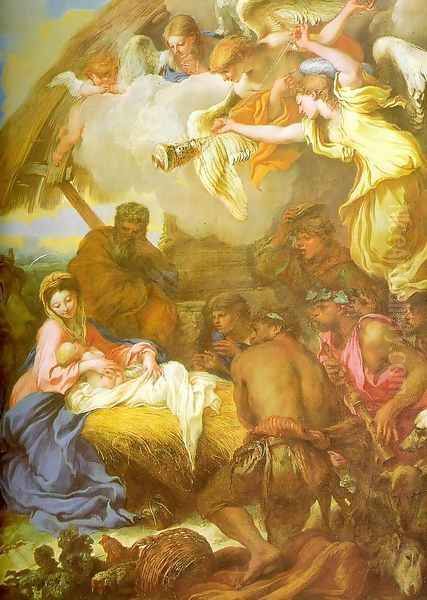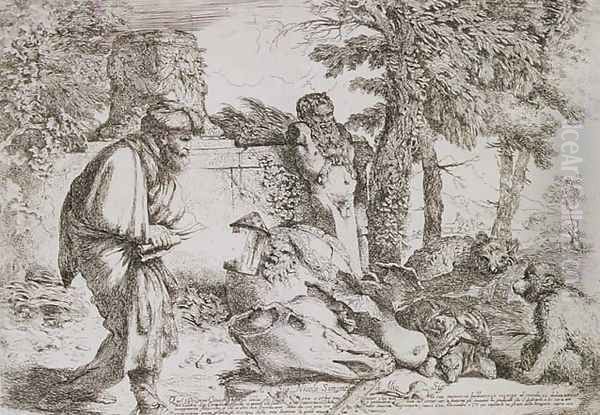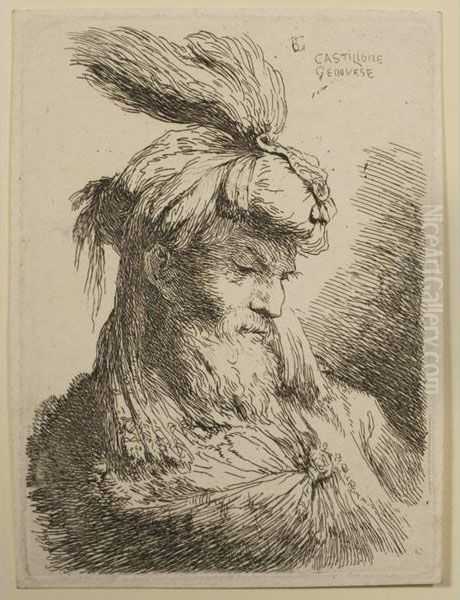Giovanni Benedetto Castiglione, also known affectionately and sometimes enigmatically as Il Grechetto, stands as one of the most innovative and versatile artists of the Italian Baroque period. Born in Genoa around 1609 and passing away in Mantua in 1664, Castiglione navigated the vibrant artistic currents of 17th-century Italy, leaving behind a rich legacy as a painter, a highly influential etcher, and the inventor of the monotype printing technique. His work, characterized by dynamic compositions, dramatic lighting, and a profound engagement with both sacred narratives and the natural world, reflects a unique synthesis of diverse influences and a restless, inventive spirit.
Genoese Beginnings and Early Influences
Genoa, Castiglione's birthplace, was a bustling maritime republic with a thriving artistic scene in the early 17th century. The city attracted prominent foreign artists and fostered its own distinct school. Castiglione's initial training likely occurred in this stimulating environment. Sources suggest he studied first with Giovanni Battista Paggi, a significant figure in the transition from Mannerism to Baroque in Genoa. He may also have spent time in the workshop of Giovanni Andrea de Ferrari or possibly Antonio de Ferrari, though Sinibaldo Scorza, a specialist in animal painting, is also cited as an early teacher, which could explain Castiglione's own lifelong fascination with depicting animals.
The Genoese artistic milieu was significantly enriched by the presence of Flemish masters. Peter Paul Rubens worked in the city intermittently between 1604 and 1607, leaving a powerful imprint with his dynamic compositions and rich colours. Anthony van Dyck resided in Genoa for a longer period, from 1621 to 1627, becoming the favoured portraitist of the Genoese aristocracy. Although Castiglione was young during their stays, the pervasive influence of their vibrant, painterly styles undoubtedly shaped his developing artistic sensibilities, particularly their energetic brushwork and dramatic flair.
Travels, Rome, and Artistic Maturation

Like many ambitious artists of his time, Castiglione sought broader horizons beyond his native city. Around 1632, he traveled to Rome, the undisputed centre of the art world. This move proved pivotal. In Rome, he encountered the works of Nicolas Poussin, whose classically ordered landscapes and historical narratives offered a counterpoint to the more exuberant Flemish Baroque. Castiglione absorbed Poussin's emphasis on structure and clarity, integrating it into his own developing style.
Rome also exposed him to the lingering influence of Caravaggio and his followers (the Caravaggisti). The dramatic use of chiaroscuro – strong contrasts between light and shadow – pioneered by Caravaggio became a key element in Castiglione's own work, particularly in his etchings. He also associated with other artists in Rome, possibly including the painter and etcher Pietro Testa, another artist known for his complex allegorical and mythological subjects and dynamic style. His time in Rome, likely lasting until around 1635, was crucial for broadening his artistic vocabulary.
Following his Roman sojourn, Castiglione's movements became somewhat peripatetic. He is documented back in Genoa by 1639, but also spent time in Naples and Venice. Naples offered exposure to a different artistic climate, potentially reinforcing the Caravaggesque tendencies through the work of artists like Jusepe de Ribera. Venice, with its rich tradition of colour and light exemplified by Titian and Tintoretto, likely further refined his handling of paint and atmosphere. These travels exposed him to a wide range of regional Italian styles and the works of numerous masters, enriching his artistic arsenal.
The Enigma of "Il Grechetto"
Castiglione became widely known by the nickname "Il Grechetto," meaning "The Little Greek." The precise origins of this moniker are debated. The provided text suggests an association between his surname, Castiglione, and Greece, though this link is obscure. A more common explanation relates to his artistic subjects; his frequent depiction of pastoral scenes, journeys through rustic landscapes filled with animals and humble figures, evoked the bucolic themes popular in ancient Greek art and literature. Others suggest it might have referred to his sometimes rough appearance or perceived foreignness in certain circles. Whatever its origin, the name stuck, becoming synonymous with his unique artistic identity.
Style, Themes, and Subject Matter

Castiglione's mature style is a fascinating blend of the influences he absorbed. It retains the dynamism and rich texture associated with the Baroque, often employing swirling compositions and energetic brushwork reminiscent of Rubens and Van Dyck. However, this is tempered by a Poussin-like attention to landscape structure and, crucially, infused with a dramatic chiaroscuro that owes a debt to both Caravaggio and, notably, the etchings of Rembrandt van Rijn. He is considered one of the first Italian artists to truly appreciate and assimilate Rembrandt's revolutionary approach to printmaking.
His subject matter was diverse. Religious themes were central, particularly narratives from the Old Testament that allowed for the inclusion of processions, crowds, and animals. Stories like Noah Leading the Animals into the Ark, the Journey of Jacob, the Adoration of the Shepherds, and the Finding of Moses were recurrent favourites. He rendered these scenes not with stiff formality, but with a sense of lived experience, often focusing on the rustic, human elements within the grand narrative. The animals in these works are never mere accessories; they are observed with keen accuracy and imbued with vitality.
Mythological subjects also featured in his oeuvre, often treated with the same blend of drama and naturalism. Beyond narrative works, Castiglione excelled in pastoral landscapes. These scenes, often depicting journeys or encampments, are populated with shepherds, travellers, and a profusion of animals – sheep, goats, cattle, horses, dogs, even camels – all rendered with remarkable skill and integrated seamlessly into atmospheric settings. Still life elements, such as copper pots, baskets, and bundles, are often prominent, depicted with a tangible sense of texture and form.
Master Etcher
While a celebrated painter, Castiglione's reputation as a graphic artist, particularly an etcher, is perhaps even more significant in art history. He was arguably the most important Italian etcher of his generation, bringing a new level of painterly richness and dramatic intensity to the medium. Deeply influenced by Rembrandt's etchings, which he studied closely, Castiglione adopted a free, sketchy line and a masterful use of light and shadow to create atmospheric depth and emotional resonance.
His etchings often explore the same themes as his paintings: biblical stories, mythological scenes, pastoral idylls, and allegorical subjects like Diogenes Searching for an Honest Man. He produced several series of prints, including notable works like the Oriental Heads, which showcase his fascination with exotic figures and his ability to capture character through expressive line and shadow. His technique involved dense networks of cross-hatching to create deep, velvety blacks, contrasted with areas left white or lightly worked to suggest brilliant light. This technical virtuosity and expressive power made his prints highly sought after and influential.
The Invention of Monotype

Castiglione's most unique contribution to art history is his invention of the monotype technique, likely developed around the mid-1640s. Monotype occupies a space between painting, drawing, and printmaking. The process typically involves drawing or painting with ink or paint directly onto a smooth, unmarked plate (like copper). While the ink is still wet, a sheet of paper is placed over the plate and pressure is applied, transferring the image to the paper.
Because most of the ink is transferred in the first printing, only one strong impression can usually be pulled, hence the name "mono-type." Subsequent impressions, sometimes called "ghost" impressions, are much fainter. This technique allowed Castiglione to achieve unique, painterly effects in print form, characterized by soft tonal gradations, rich textures, and a sense of spontaneity impossible to achieve with traditional etching or engraving. His monotypes, such as The Creation of Adam or various depictions of God the Father, possess a remarkable fluidity and atmospheric quality. Though not widely adopted immediately, the technique was later revived by artists like Edgar Degas in the 19th century.
Key Works: A Glimpse into His Art
Several works stand out as representative of Castiglione's style and thematic concerns. Noah Leading the Animals into the Ark (versions exist in several collections) perfectly encapsulates his love for animal depiction and complex narrative, showing a bustling procession entering the ark under dramatic skies. The Raising of Lazarus showcases his mastery of chiaroscuro and emotional intensity, capturing the miraculous event with Baroque dynamism.
His pastoral scenes, such as The Journey of Jacob or similar depictions of travelling families and their flocks, highlight his skill in landscape and animal painting, creating idyllic yet tangible worlds. The Adoration of the Shepherds allowed him to combine religious devotion with rustic realism and dramatic lighting. Works like Diogenes Searching for an Honest Man demonstrate his engagement with philosophical and allegorical themes, often set within richly detailed, almost chaotic compositions filled with figures and animals. His numerous drawings, often executed in oil paint on paper, further reveal his fluid draughtsmanship and compositional inventiveness, frequently standing as finished works of art in their own right.
Patronage in Mantua and Later Life

Despite his travels, Castiglione maintained connections with Genoa but eventually found stable patronage in Mantua. From around 1651, he worked extensively for the court of Duke Carlo II Gonzaga. Mantua had a distinguished artistic history, having previously hosted artists like Andrea Mantegna and Giulio Romano. Serving as court painter provided Castiglione with prestige and regular commissions, allowing him to produce large-scale paintings and decorative works. He remained in Mantua for much of the remainder of his life, dying there in 1664. His son, Francesco Castiglione, also became a painter, often working in a style very similar to his father's.
A Turbulent Personality
Contrasting sharply with the sensitivity and skill evident in his art was Castiglione's notoriously difficult personality. Contemporary accounts and legal records paint a picture of a man prone to fits of rage, arrogance, and violence. He was involved in numerous disputes and faced serious accusations throughout his life. Reports mention him being accused of assault, theft, attempting to push his own sister from a roof, and even involvement in the death of a nephew, though the veracity of some of the more extreme claims is hard to ascertain definitively.
He faced lawsuits and was reportedly imprisoned in Rome for a period. This turbulent aspect of his character adds a layer of complexity to his biography. It suggests a restless, perhaps tormented spirit underlying the creator of often serene pastoral scenes and profound religious narratives. His difficult nature may have contributed to his frequent relocations, perhaps seeking new patrons or fleeing trouble.
Influence and Legacy
In his own time and throughout the 18th century, Castiglione's work was highly esteemed. His paintings were collected by connoisseurs, and his etchings, in particular, circulated widely, profoundly influencing subsequent generations of printmakers. Artists like Giovanni Battista Piranesi, known for his dramatic views of Rome, clearly absorbed lessons from Castiglione's handling of light and architectural rendering in etching. The Rococo masters in France, including Antoine Watteau and François Boucher, admired the pastoral charm and fluid grace of his compositions. Jean-Honoré Fragonard also shows echoes of Castiglione's feathery brushwork and rustic themes.
Italian artists also felt his impact. Figures like Pier Francesco Mola and Giovanni Battista Pace incorporated elements of his style. The great Venetian painter Giovanni Battista Tiepolo and his son Giovanni Domenico Tiepolo were known collectors and admirers of his prints, whose influence can be detected in their own graphic work. His innovative approach to technique and his ability to synthesize diverse influences made him a key figure in the development of Baroque art.
Obscurity and Rediscovery

Despite his 17th and 18th-century fame, Castiglione's reputation waned significantly during the 19th century. Changing tastes, perhaps favouring Neoclassicism or later Romanticism, led to his work being overlooked. The complexities and sometimes rough finish of his paintings may have fallen out of favour compared to more polished academic styles. For a considerable period, he was relegated to the status of a minor master.
However, the later 20th century witnessed a significant reassessment of his work. Renewed scholarly interest and major exhibitions brought his art back into the spotlight. Art historians recognized the true extent of his innovation, particularly in printmaking, and his pivotal role within the Genoese school and the broader Italian Baroque. His mastery of different media, his unique synthesis of influences, and his invention of the monotype secured his place as a major figure. Today, his works are prized possessions in leading museums worldwide, including the Royal Collection at Windsor Castle, the Louvre in Paris, the Kunsthistorisches Museum in Vienna, the Metropolitan Museum of Art in New York, and the Denver Art Museum, among many others.
Conclusion: An Inventive Baroque Spirit
Giovanni Benedetto Castiglione, "Il Grechetto," remains a compelling figure in art history. He was an artist of exceptional versatility, moving fluidly between painting, drawing, and etching, and even inventing a new graphic technique. His work embodies the energy and drama of the Baroque, enriched by influences ranging from the Flemish masters and Poussin to Caravaggio and Rembrandt. He excelled in depicting the natural world, particularly animals, integrating them into complex narrative and pastoral scenes imbued with atmospheric light and shadow. Despite a turbulent life and a period of later neglect, Castiglione's innovative spirit and powerful artistic vision have ensured his recognition as a unique and significant master of the Italian Baroque, whose influence resonated through the graphic arts and painting for generations.